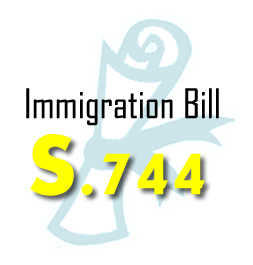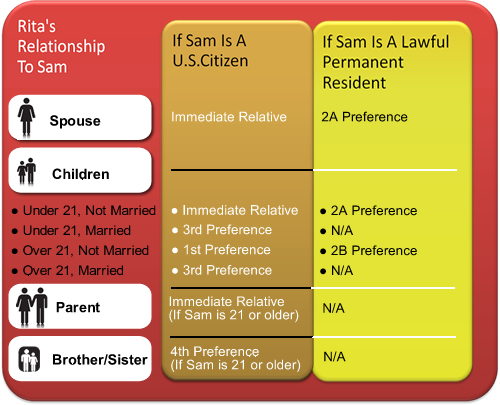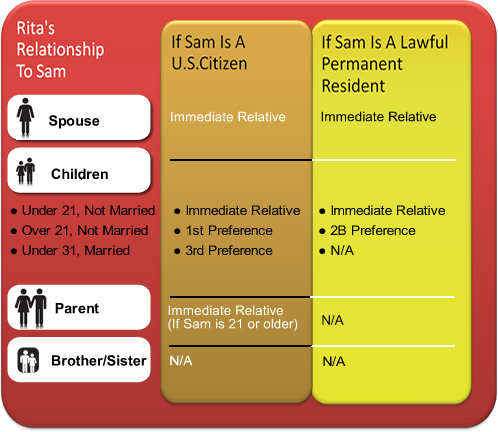
If and when reform legislation is passed, many aspects of immigration law will undergo major transformation.
None will change more dramatically than the family-based immigration system for aspiring permanent residents.
At present, this is how the system looks:
Who You Can Immigrate (Pre-S.744)

And here is a short glimpse at the changes under the Senate’s immigration reform proposal:
Who You Can Immigrate (Post-S.744)

Three Proposed Family-Based
Immigration Changes
As can be noted by comparing the two graphs, there are three changes being made to the eligibility of potential immigrant beneficiaries.
- First, the immigrant spouses and children (unmarried, under 21) of lawful permanent residents would be moved from the 2A family preference category to immediate relatives.
- Second, immigrant sons and daughters of U.S. citizens would only qualify for green cards if they are under 31 at the time their parents file I-130 family-based applications for them.
- Third, U.S. brothers and sisters will no longer be able to sponsor their immigrant siblings for immigration benefits.
Will Immigration Reform Help
Or Hurt Your Family?
Each situation varies. So let’s take a brief look at the proposed changes from a practical day-to-day perspective.
Husbands, Wives, And Children Of LPRs
Nearly all lawful permanent residents will celebrate the news about being able to immediately sponsor their spouses and children for permanent residency.
At present, after all, the wait for a green card is several years.
Such elation, however, is likely to subside once the provisions of S.744 are implemented.
Under the Senate proposal, a merit-based approach for selecting future permanent immigrants will supplant the relationship-based family immigration system currently in place.
Key criteria will include:
- Education
- Employment Experience
- Civic Involvement
- English Proficiency
- Age
- Country Of Origin
According to the Center For Human Rights And Citizenship, due to the complexity of the Senate Bill requirements, approximately four to five million low-income immigrants will fail in their quest for legalization.
Based on a pool of 11 million undocumented immigrants, that’s nearly 50% who will be remain vulnerable to deportation and removal.
Married Sons And Daughters, Over 31, Of U.S. Citizen Parents
If S.744, or legislation closely similar, becomes law, immigrant children who are married and over 31, will be out of luck.
The best strategy, in my view as a San Diego immigration attorney, is to file immediately if you or your relative is this category.
Of course, there are other factors which need to be assessed before taking this step.
Yet, generally speaking, if you know a U.S. citizen who is thinking about helping an immigrant brother or sister, over or nearing the age of 31, you should recommend filing a family-based immigrant petition as soon as possible.
Once their initial set of paperwork is submitted, it should help them avoid the cut-off date to be set by Congress.
Immigrant Brothers And Sisters Of U.S. Citizens
Akin to married immigrant children over 31, brothers and sisters of U.S. citizens will no longer be eligible for sponsorship of a family-based petition if S.744, as currently proposed, is passed and becomes the law.
Again, in general, the best strategy is to move forward quickly.
By filing now for a family unity petition, immigrant siblings, over 31, of U.S. citizens should be enabled to complete the green card process already started.
Less Visas For Family Members?
As a green card lawyer, I am not a fan of the proposed changes.
I believe when all is said is said and done under S.744, the pool of individuals eligible to immigrate via family members will shrink.
Having assisted immigrants who have filed family-based I-130 visa petitions for several years, it seems the road to legalization will become more difficult than ever before.
This outcome should be no surprise.
Back in early March, Congressional correspondent David Grant forewarned immigrant supporters.
“Lawmakers of both parties have made it clear, he wrote in The Christian Science Momitor, “they want to make it easier for graduates of advanced science, technology, engineering, and math programs to stay in the US and for a range of foreign workers – from farm workers to computer scientists – to come here.”
He added, “But what the parties still have to resolve is whether those work-based visas should come at the expense of some family-based immigration slots.”
Overall, three approaches exist for setting numerical limits on immigrant visas. Two are politically unacceptable for the majority of Congressional representatives.
The number of visas available for immigrants could be increased. This method would allow the level of family-based visas to stay the same, while employment-based visas increase.
An alternate approach, favored by immigration reform opponents, is to decrease current visa levels.
Neither is likely to occur.
The third, and most likely option, is to simply keep the total number of visas more or less at the same levels.
This means, since Congress wants more employment-based visas, the number of visas available for filing family-based applications must fall.
A merits-based system merges the two current systems.
S.744 eliminates the employment-based system and transforms the family-based system.
The legislation creates a hybrid system, slanted away from lower income immigrants with less education, literacy, and employment skills.
But the question then becomes, “Do we really have a family-based system any longer?”
By Carlos Batara, Immigration Law, Policy, And Politics




